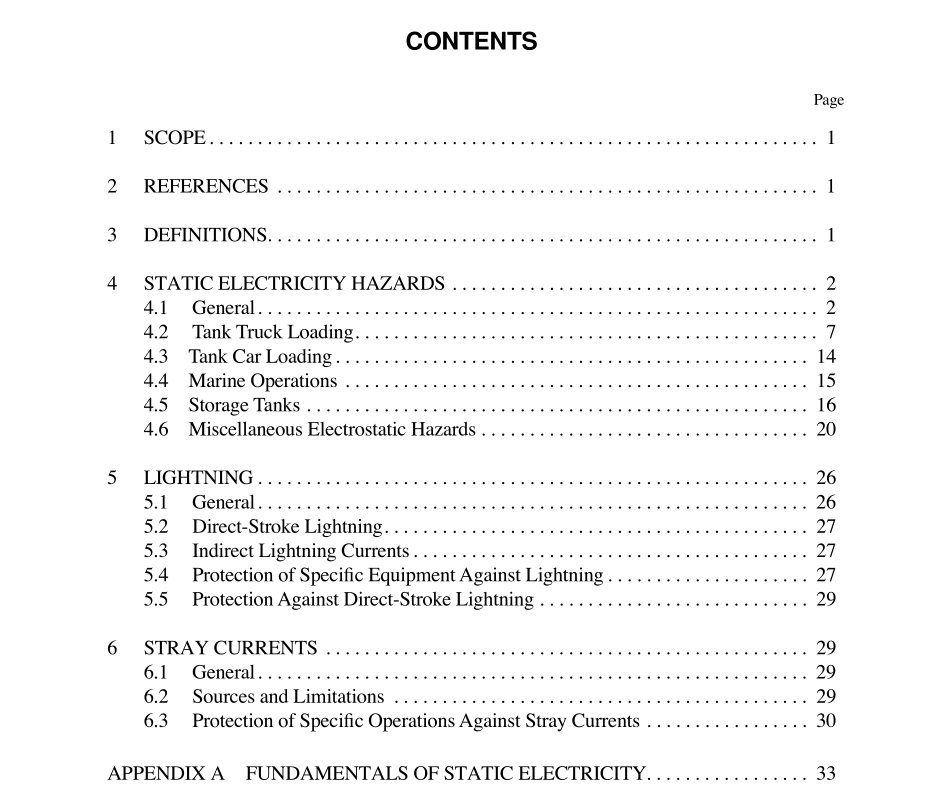API RP 2003 pdf download

API RP 2003 pdf download.Protection Against Ignitions Arising out of Static, Lightning, and Stray Currents
1 Scope
This recommended practice presents the current state of knowledge and technology in the Þelds of static electricity, lightning, and stray currents applicable to the prevention of hydrocarbon ignition in the petroleum industry and is based on both scientiÞc research and practical experience. Further- more, the principles discussed in this recommended practice are applicable to other operations where ignitable liquids and gases are handled. Their use should lead to improved safety practices and evaluations of existing installations and proce- dures. When the narrow limits of static electricity ignition are properly understood, Þre investigators should be encouraged to search more diligently for the true ignition sources in instances where static ignition is unlikely or impossible. This recommended practice is not required under the fol- lowing conditions: a. Static discharges may occur, but ßammable vapors are always excluded by gas freeing or inerting the atmosphere in the area of discharge. b. Product handling occurs in a closed system, and oxygen in that system is always below the minimum concentration required to support combustion, such as in the handling of liqueÞed petroleum gas (LPG). c. The ßammable concentration is always above the upper ßammable limit (UFL). This document does not address electrostatic hazards relat- ing to solids handling. (See [12] and [13] in the bibliography.)
3 Definitions
3.1 arc: A low-voltage, high-current electrical discharge that occurs at the instant two points, through which a large current is ßowing, are separated. Technically, electrostatic discharges are always sparks, not arcs. 3.2 bonding: The practice of providing electrical connec- tions between isolated conductive parts of a system to pre- clude voltage differences between the parts (see Figure A-5). A bond resistance as high as 1 megohm (106 ohm) is adequate for static dissipation. For stray current protection, lightning protection, and other electrical systems, the bonding resistance needs to be signiÞcantly lower, no more than a few ohms. 3.3 closed connection: A connection in which contact is made before ßow starts and is broken after ßow is com- pleted (e.g., in bottom loading of tank trucks). 3.4 combustible liquid: A liquid with a ßash point at or above 38¡C (100¡F). 3.5 conductivity ( ): The capability of a substance to transmit electrostatic charges, normally expressed in picoSie- mens per meter (pS/m) for petroleum products. Conductivity is also expressed in conductivity units (C.U.) where 1 C.U. = 1 pS/m = 1 x 10 -12 siemens per meter = 1 x 10 -12 ohm -1 m -1 . 3.6 flammable liquid: Liquid having a ßash point below 38¡C (100¡F) and having a Reid vapor pressure not exceed- ing 276 kPa (40 psia). 3.7 grounding: The practice of providing electrical conti- nuity between a fuel handling system and ground or earth to ensure that the fuel handling system is at zero potential (see Figure A-6). A resistance as high as 1 megohm is adequate for static dissipation. For other purposes, such as electrical sys- tems, lightning protection, etc., much lower resistances are needed. 3.8 high vapor pressure products: Liquids with a Reid vapor pressure above 4.5 psia (31 kPa). These products include aviation and motor gasoline and high vapor pressure naphtha. 3.9 intermediate vapor pressure products: Flamma- ble liquids with a Reid vapor pressure below 4.5 psia (31 kPa) and a closed-cup ßash point of less than 38¡C (100¡F). These can form ßammable vapors at ambient operating tempera- tures. Examples of these products are commercial aviation fuel (Jet B), military aviation turbine fuel (JP-4 (TF-4)), and solvents such as xylene, benzene, and toluene. 3.10 low vapor pressure products: Liquids with closed cup ßash points above 38¡C (100¡F). Examples of these products include heating oil, kerosene, diesel fuel, com- mercial aviation turbine fuel (Jet A), and safety solvents.









